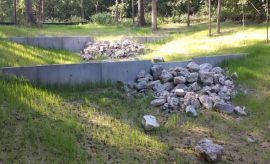Swales with Check Dams

Brief Description
A check dam is a structure installed perpendicular to flow in a conveyance channel to reduce flow velocity. By slowing flow velocities, check dams can serve multiple functions including enhancement of sediment trapping, and greater treatment of the water quality control volume via enhanced water detention or retention.
Cost Range
Construction: $
O&M: $$
Ideal Conditions for Installation
Slopes steeper than 3% but less than 10%.
10 acres maximum tributary area.
Small open channels.
Where/Applicability
- Check dams are suitable only for a limited drainage area (generally 10 acres or less)
- Check dams are intended for use in small open channels, not streams or rivers.
- Hydraulic capacity of the channel can be reduced when check dams are in place.
- Check dams may create turbulence downstream, causing erosion of the channel banks.
- Ponded water may kill grass or other vegetation in dry swales, wet swales, and stormwater step pools.
- Check dams may be an obstruction to construction equipment.
Maintenance
Frequency: Inspect after each runoff event.
Type:
- Remove sediment accumulated behind dam.
- Restore dislodged or washed out check dams.
- Fill in or otherwise repair erosion areas
- If check configuration is resulting in excessive failures, consider other designs and replace.
Monitoring: Quarterly
Permit Renewal: Five years
Performance
Total Suspended Solids: Depends upon the relation of design volume to storm event. TSS removal can be high for small storms.
Specifications
Planning guidelines and material selection for check dams are driven by site considerations (e.g., swale slope, length, flow velocities, soils) and the longevity desired. In general, swale slope should not exceed 10 percent (otherwise, a drop structure should be considered), the drainage area should not exceed 10 acres, and flow velocities should not exceed 12 feet per second for a 10-year, 24-hour storm frequency.
Construction Sequence
1. Pretreatment is recommended to remove sediments and floatables.
2. Select a check dam type to meet longevity and other design objectives.
3. Complete final grading of the swale and rock/debris removal prior to check dam installation.
4. Channel protection and stabilization (i.e., with turf reinforcement mats, Type 3 or 4 erosion control blankets, seed, etc.) should be achieved prior to installation of check dams.
5. Install check dams immediately after swale stabilization (i.e., seeding and mulching or installation of rolled erosion control products).
6. Install check dams across entire width of swale, perpendicular to the flow.
7. Configure check dams so the sides extend up the bank slopes, with the overflow in the middle.
8. Check dams should be keyed into the side slope a minimum of 3 feet.
9. Overflow dips in the middle of the check dam should be 1 foot lower than the sides.
10. Ensure culvert entrances below check dams are not subject to damage or blockage from displaced stones.
11. Protect the channel downstream of the lowest check dam from erosion, since water will flow over and around the dam.
12. Ensure that the channel is stable above the most upstream check dam.
Downloads
Swales with Check Dams DWG
File:CheckDamsSwales.pdf
Links
Minnesota Stormwater Manual
https://stormwater.pca.state.mn.us/index.php?title=Check_dams_for_stormwater_swales
Design Standard
Cross section
File:CheckDamsSwales.pdf